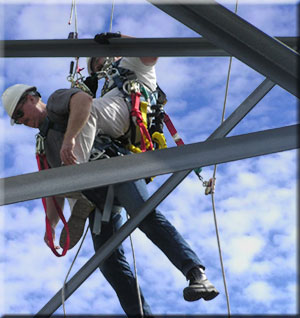|
Fate of eleventh hour attempt by NATE to change NC safety standard may be decided on Monday
August 19, 2005 -- For more than five years the National Association of Tower Erectors and the North Carolina Department of Labor partnered to assemble the nation's first state communications tower standard, legislation that is being closely observed by other state occupational, safety and health organizations that might adopt it.
The fall protection section of the standard was to be effective April 1, along with the other eight sections, but NATE registered their concern with NCDOL about the language regarding high angle rescue requirements and both groups found there was strong disagreement following initial meetings and revisions.
High angle rescue is primary concern
To break the impasse, NATE's North Carolina lobbyist, David Huskins, solicited Republican Assemblyman John Blust to introduce House Bill 806 on March 21, requesting disapproval of the State's Rules Review Commission's approval of the fall protection section .
At issue is when an employee is prepared to receive and effectively utilize rescue training. The NCDOL standard requires that when two employees are on a tower site, one has to be trained in high angle rescue and the second employee must also have the same training if he has been with the company for six months. NATE believes that this is too short of a time for a new employee to be taught basic tower climbing as well as rescue training and believes 12 months would better serve the safety of tower workers.
 The standard also allows an employer to designate a third party to perform rescue procedures, but requires the tower service company to evaluate the rescue team or service's abilities to provide competent and timely rescues. NATE also took exception to this language and requested that the rescue company should be tasked with providing its own competency certification, said Huskins. The standard also allows an employer to designate a third party to perform rescue procedures, but requires the tower service company to evaluate the rescue team or service's abilities to provide competent and timely rescues. NATE also took exception to this language and requested that the rescue company should be tasked with providing its own competency certification, said Huskins.
Blust's bill did not make it through one chamber and did not meet the crossover deadline of June 2. Therefore, the fall protection standard was expected to take effect as written following the General Assembly's adjournment this month. However, Huskins quickly lobbied lawmakers to get the standard placed in the Technical Corrections Bill with 12 months being designated as the requisite number of months allowable for a new employee to be trained in rescue along with competency documentation being a requirement of the rescue firm.
NCDOL officials may have been unaware of the last minute revisions submitted to be placed in their standard until the draft version of the bill was released last Friday.
"The Technical Corrections Bill, typically heard on the last days of the legislative session," Huskins said, "entitles NATE to exercise the due process provided by the General Assembly in its administrative procedures act. Because they were not making progress with the department of labor, the statutes are set up to allow the General Assembly to get involved in issues if interest groups do not feel that they are being adequately heard by agencies."
This is NATE's last recourse, but it might be short lived. The bill will be heard by the Senate Judiciary Committee on Monday afternoon, but it can change dramatically between now and then. NATE's language in the draft could be taken out of the final bill or it might be modified. If the Chairman asks for discussion on the changes it is expected that General Counsel John Hoomani will represent NCDOL's position and Huskins will present NATE's views. If the bill moves out of committee and receives approval on the full floor then it will go before the house and the house can concur with it or suggest that there be changes. It would then become law the day after the session closes which could be as early as next week.
Nine month compromise not accepted
During discussions prior to June, NATE had floated a compromise of a nine-month limit before the second employee was required to have high angle rescue training, but NCDOL was not receptive, said Huskins.
"It's a difficult issue and I think that we're not that far apart, and we would certainly embrace some type of compromise on this issue," he explained.
No matter what the outcome is next week, NATE Administrator Patrick Howey believes that there has been a substantive achievement by both sides in developing the communications standard. He noted that the rescue area is a small segment of the overall standard, stating that NATE firmly believes that six months is not enough time to ensure that a new employee will be proficient enough to extricate an injured worker from a tower. Hoomani has said that the erectors association has not provided documentation to support their assertion that six months is too soon to be trained.
If the standard takes effect next week, tower service companies will have to scramble their resources or, in an already tight labor market, hire new employees to be in compliance. Some businesses will chose not to follow the new rules, a concern of companies that have heavily invested in employee training.
Although they aren't anxious for increased NCOSH inspections, critics believe that in order for the rescue training to be embraced, the state must provide the resources to ensure that all companies are following the standard and cite those that do not comply.
"Otherwise," a North Carolina contractor said, "it's still going to be the same problem. You're going to have jackleg crews come in that do not comply, don't want to comply, and do the job at pricing that compliant companies can't meet." comply, don't want to comply, and do the job at pricing that compliant companies can't meet." 
Copyright © Wireless Estimator, Inc. Please request reprint permission.
|